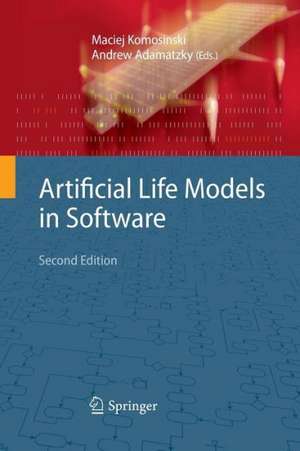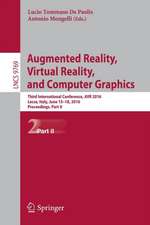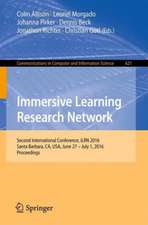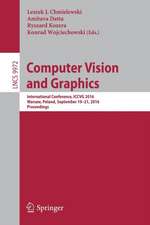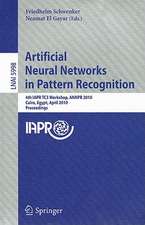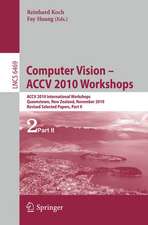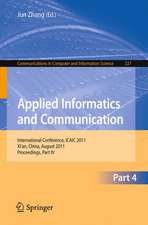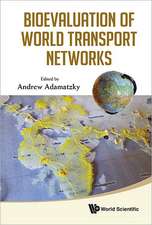Artificial Life Models in Software
Editat de Maciej Komosinski, Andrew Adamatzkyen Limba Engleză Paperback – 28 noi 2014
| Toate formatele și edițiile | Preț | Express |
|---|---|---|
| Paperback (1) | 995.24 lei 6-8 săpt. | |
| SPRINGER LONDON – 28 noi 2014 | 995.24 lei 6-8 săpt. | |
| Hardback (1) | 999.02 lei 6-8 săpt. | |
| SPRINGER LONDON – 14 iul 2009 | 999.02 lei 6-8 săpt. |
Preț: 995.24 lei
Preț vechi: 1244.05 lei
-20% Nou
Puncte Express: 1493
Preț estimativ în valută:
190.46€ • 206.81$ • 159.99£
190.46€ • 206.81$ • 159.99£
Carte tipărită la comandă
Livrare economică 23 aprilie-07 mai
Preluare comenzi: 021 569.72.76
Specificații
ISBN-13: 9781447156925
ISBN-10: 1447156927
Pagini: 464
Ilustrații: XXI, 441 p.
Dimensiuni: 155 x 235 x 24 mm
Greutate: 0.64 kg
Ediția:2nd ed. 2009
Editura: SPRINGER LONDON
Colecția Springer
Locul publicării:London, United Kingdom
ISBN-10: 1447156927
Pagini: 464
Ilustrații: XXI, 441 p.
Dimensiuni: 155 x 235 x 24 mm
Greutate: 0.64 kg
Ediția:2nd ed. 2009
Editura: SPRINGER LONDON
Colecția Springer
Locul publicării:London, United Kingdom
Public țintă
ResearchCuprins
Virtual Environments.- Avida.- Foundations of and Recent Advances in Artificial Life Modeling with Repast 3 and Repast Simphony.- Sodarace.- 3D Multi-Agent Simulations in the breve Simulation Environment.- Framsticks.- Lattice Worlds.- StarLogo TNG.- From Artificial Life to In Silico Medicine.- Discrete Dynamics Lab.- EINSTein.- Artificial Chemistries.- From Artificial Chemistries to Systems Biology.- Spatially Resolved Artificial Chemistry.- Artificial Life Arts.- Simulated Breeding.- The Evolution of Sonic Ecosystems.- Enriching Aesthetics with Artificial Life.
Recenzii
From the reviews of the second edition:“Inducing biological functioning into a computing system has always been an interesting topic. It is quite difficult to confirm whether we can make a computing system behave as a life element. This book provides applications, philosophies, and tools that help provide artificial life models in software. … the book provides detailed descriptions of frameworks, applications, and approaches used in artificial life models in software. This well-written book includes chapters that relate nicely to each other, helpful figures, and in-depth discussions of the various topics.” (Varadraj Gurupur, ACM Computing Reviews, February, 2010)
Textul de pe ultima copertă
Artificial Life Models in Software provides an introduction and guide to modern software tools for modeling and simulating life-like phenomena, written by those who personally design and develop software, hardware, and art installations in artificial life, simulated complex systems and virtual worlds.
This timely volume offers a nearly exhaustive overview and original analysis of major non-profit software packages that are actively developed and supported by experts in artificial life and software design. The carefully selected topics include:
• simulation and evolution of real and artificial life forms,
• natural and artificial morphogenesis,
• self-organization,
• models of communication and social behaviors,
• emergent collective behaviors and swarm intelligence,
• agent-based simulations,
• autonomous and evolutionary robotics,
• adaptive, complex and biologically inspired ecosystems,
• artificial chemistries,
• creative computer art.
The models of life presented here are essential components in undergraduate and post-graduate courses in complex adaptive systems, multi-agent systems, collective robotics and nature-inspired computing. Readers interested in artificial life, evolutionary biology, simulation, cybernetics, computer graphics and animation, neuroscience, cognitive science, and philosophy will find this monograph a valuable guide and an excellent resource for supplementary reading.
This timely volume offers a nearly exhaustive overview and original analysis of major non-profit software packages that are actively developed and supported by experts in artificial life and software design. The carefully selected topics include:
• simulation and evolution of real and artificial life forms,
• natural and artificial morphogenesis,
• self-organization,
• models of communication and social behaviors,
• emergent collective behaviors and swarm intelligence,
• agent-based simulations,
• autonomous and evolutionary robotics,
• adaptive, complex and biologically inspired ecosystems,
• artificial chemistries,
• creative computer art.
The models of life presented here are essential components in undergraduate and post-graduate courses in complex adaptive systems, multi-agent systems, collective robotics and nature-inspired computing. Readers interested in artificial life, evolutionary biology, simulation, cybernetics, computer graphics and animation, neuroscience, cognitive science, and philosophy will find this monograph a valuable guide and an excellent resource for supplementary reading.
Caracteristici
Second edition includes new chapters on Breve, Netlogo and Artificial Chemistry Written by the developers of the software
